Examples of weird birds include the horned screamer, known for its unique horn and loud call; the blue-footed booby, with its bright blue feet; the kakapo, a nocturnal, flightless parrot; the oilbird, which navigates using echolocation like a bat; and the blood-drinking vampire ground finch, a species found only on the Galápagos Islands.
On this page, you’ll meet these and many other weird birds from all around the world.
Weird Birds List
You can see more weird animals on the following pages:
Weird Animals Pictures & Facts
Weird Fish Pictures & Facts
Ugly Animals Pictures & Facts
Find out more about birds on the following pages:
Birds – The Ultimate Guide
Types of Birds
Andean Cock Of The Rock
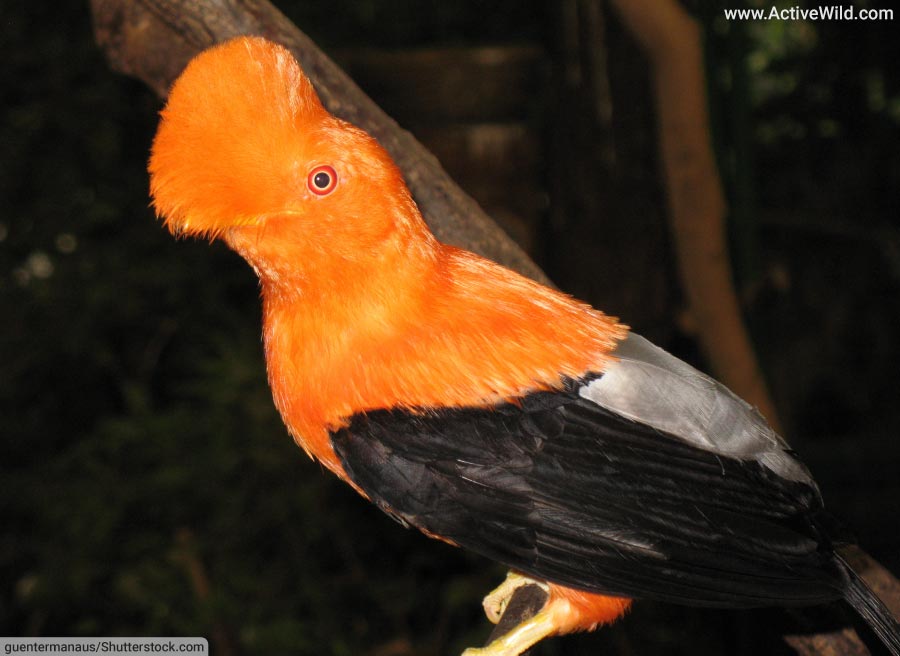
Scientific name: Rupicola peruvianus
Family: Cotingidae
IUCN conservation status: Least Concern
The Andean Cock of the Rock is a brightly-colored bird found in the cloud forests and subtropical rainforests of the Andean mountains in South America.
The species is primarily known for the striking appearance of the male, who has a brilliant orange-red crest, head and chest. As with many bird species, the female is far less colorful, being a rufous-brown.
The Andean Cock of the Rock is around 30 cm in length and weighs up to 225 g, with males being larger than females. The species is omnivorous, feeding on a variety of fruits, insects, and small vertebrates.
Due to its widespread distribution and stable population, the species is not currently considered threatened, although habitat loss and fragmentation are potential threats to its long-term survival.
Discover More with Active Wild
You can see more South American animals on this page: South American Animals
You can see more rainforest animals on this page: Rainforest Animals List with Pictures & Facts
Birds-Of-Paradise
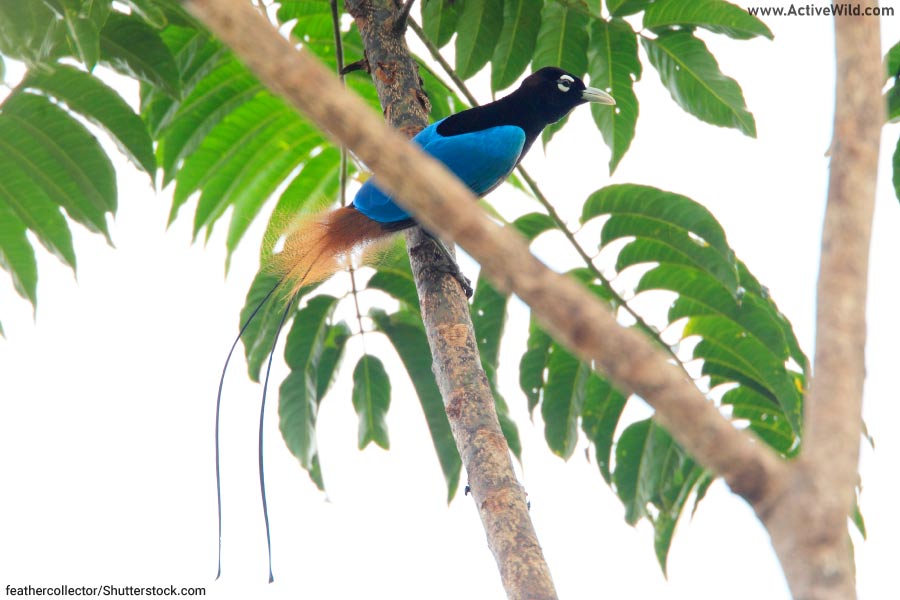
Family: Paradisaeidae
IUCN conservation status: Varies by species
Birds-of-Paradise are a family – Paradisaeidae – of birds found mainly in New Guinea and nearby islands, as well as parts of Australia and the Moluccas. They are known for the elaborate and colorful plumage of the males, who often perform elaborate courtship displays to attract mates.
Male birds-of-paradise are often more brightly colored and ornate than females, with striking feathers, crests, and other adornments.
There are more than 40 different species of birds-of-paradise, each with their own unique courtship displays and vocalizations. Many species are also known for their complex mating systems, often involving a “lek”, which is a type of “dance-off” in which males compete for mating rights with watching females.
Although birds-of-paradise are threatened by habitat loss and hunting for their feathers, most members of the family, including species such as the King Of Saxony bird of paradise, ribbon tailed astrapia, and the three superb bird of paradise species, have the IUCN conservation status “Least Concern”.
Discover More with Active Wild
You can see more Australian animals on this page: Australian Animals
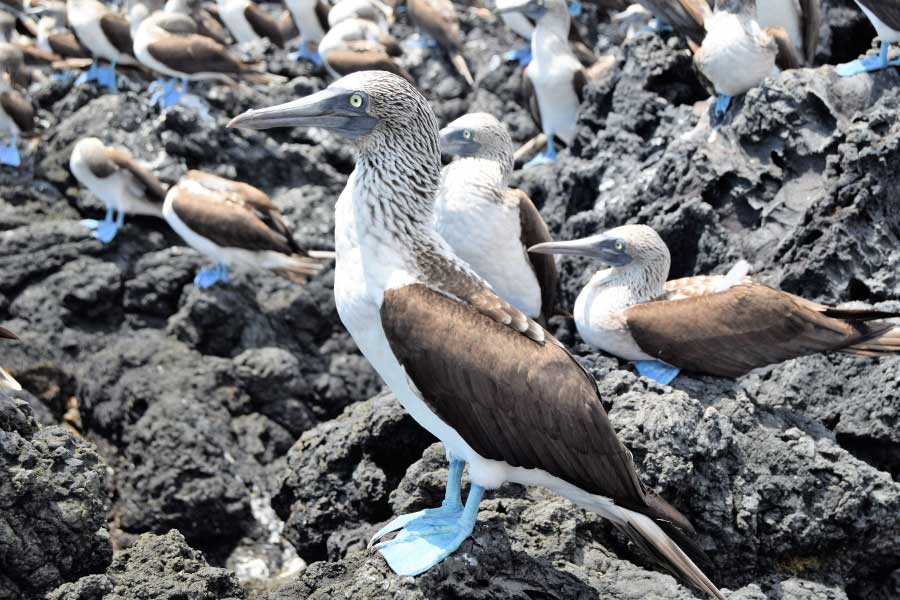
Scientific name: Sula nebouxii
Family: Sulidae
IUCN Conservation Status: Least Concern
The Blue-Footed Booby is a medium-sized seabird known for its distinctive bright blue feet. It has a wingspan of about 5 feet and a streamlined body, which is white with brownish-grey upper wings.
Found mainly along the western coasts of Central and South America, the Blue-Footed Booby feeds on fish by diving into the ocean from considerable heights.
The species is one of six boobies, which together make up the genus Sula.
Discover More with Active Wild
You can see more South American animals on this page: South American Animals
Bower Birds
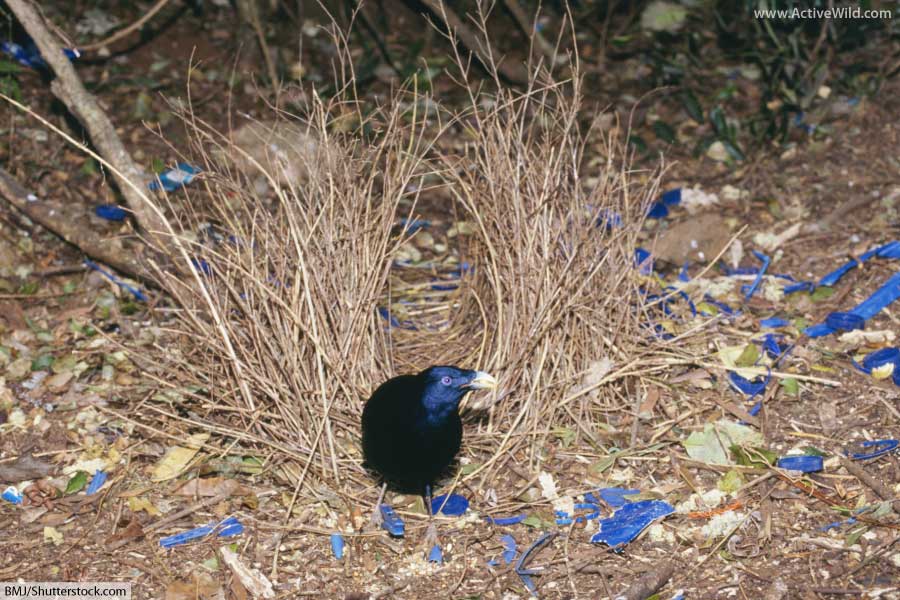
Family: Ptilonorhynchidae
IUCN Conservation Status: Varies by species
Bowerbirds are a unique family of birds found in Australia and Papua New Guinea. They are renowned for their elaborate courtship rituals, in which males construct intricate, meticulously decorated bowers to attract mates.
Interestingly, the bower itself has no other use other than to attract females; once mating has taken place, the female builds a nest and raises the chicks by herself.
Bowerbirds exhibit a wide range of colors and sizes, with some species sporting iridescent plumage.
Discover More with Active Wild
Discover more amazing Australian birds on this page: Australian Birds List
You can see more Australian animals on this page: Australian Animals
Burrowing Owl
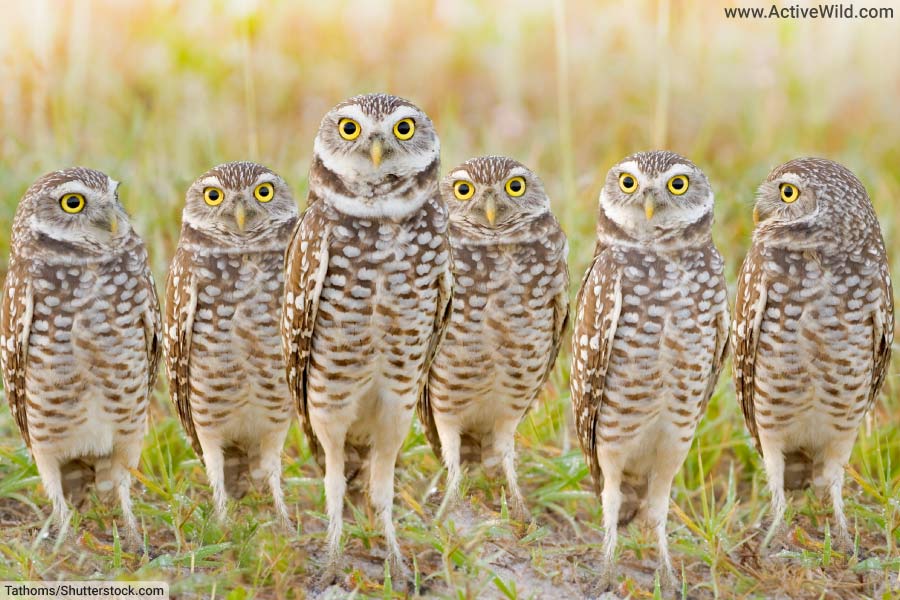
Scientific name: Athene cunicularia
Family: Strigidae
IUCN Conservation Status: Least Concern
The Burrowing Owl is a small, ground-dwelling owl with bright yellow eyes and long legs. It is found in grasslands, deserts, and other open habitats across the Americas.
Unlike most owls, the Burrowing Owl is active during the day and lives in burrows dug by other animals, such as prairie dogs or ground squirrels.
Discover More with Active Wild
You can see more North American animals on this page: North American Animals
You can see more animals that live in grasslands on this page: Grassland Animals
Flightless Cormorant

Scientific name: Phalacrocorax harrisi
Family: Phalacrocoracidae
IUCN Conservation Status: Vulnerable
The Flightless Cormorant is a large, dark, flightless bird found on the Galápagos Islands. Like many Galápagos Island species, it is endemic to the islands, which means that it is found nowhere else on Earth.
This weird bird has small, vestigial wings and strong legs, which it uses to swim and dive for fish and other aquatic prey. The loss of flight is an adaptation to its island habitat, where it faces few terrestrial predators.
Discover More with Active Wild
You can see more South American animals on this page: South American Animals
Frogmouth

Family: Podargidae
IUCN Conservation Status: Varies by species
Frogmouths are a family of nocturnal birds native to Australia, Southeast Asia, and the Indian Subcontinent.
These weird-looking birds are characterized by their large, frog-like mouths, wide heads, big eyes, and cryptic plumage that blends in with tree bark. They perch motionlessly on branches during the day, relying on their amazing camouflage to avoid detection.
Frogmouths are primarily insectivorous, but larger species also target small invertebrates.
The majority of frogmouths are not presently threatened, but a number of species, including the large frogmouth and Bornean frogmouth, are rated “Near Threatened” by the IUCN.
Discover More with Active Wild
You can see more Australian animals on this page: Australian Animals
Greater Sage Grouse
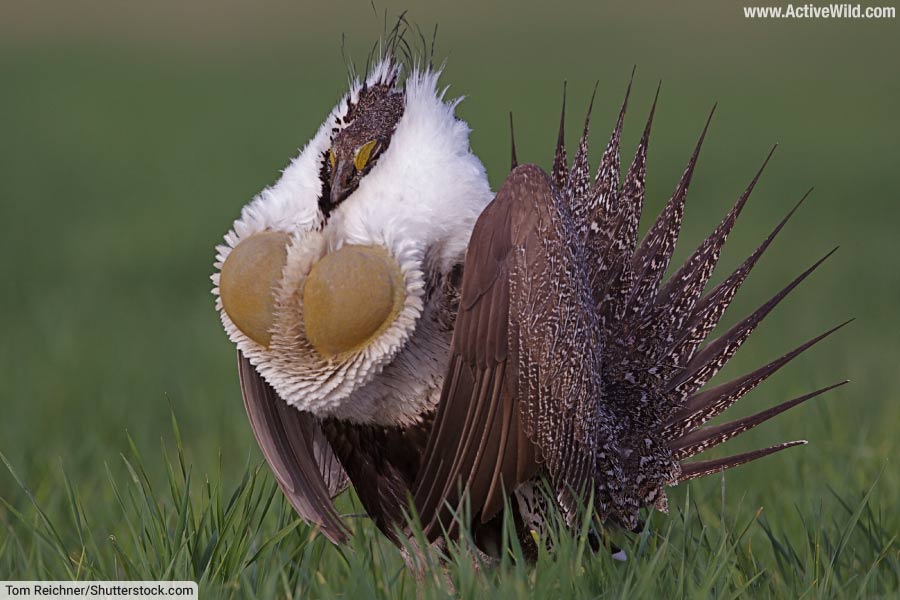
Scientific name: Centrocercus urophasianus
Family: Phasianidae
IUCN Conservation Status: Near Threatened
The Greater Sage Grouse is a large, ground-dwelling bird found in the sagebrush habitats of western North America. It is known for its striking appearance, with a long, pointed tail, a spiky collar of white feathers, and males having yellow air sacs on their chests.
The species performs elaborate mating dances in lekking grounds, where males gather to display their impressive plumage and puff their chests to watching females. The lek is vitally important for a male; the most impressive performer will mate with up to 80% of the females.
Discover More with Active Wild
You can see more North American animals on this page: North American Animals
Hoatzin

Scientific name: Opisthocomus hoazin
Family: Opisthocomidae
IUCN Conservation Status: Least Concern
The Hoatzin is a weird bird found in the swamps and mangroves of the Amazon Basin in South America.
The species has an unusual appearance, with a crest of feathers on its head, bright blue facial skin, and red eyes.
However, the hoatzin’s appearance is not the reason for its inclusion in this list of weird birds. What’s really unusual about this species is its unique digestive system, which relies on fermentation to break down leaves consumed by the bird. This results in a strong, unpleasant odor, giving the hoatzin its unfortunate nickname of “stinkbird”.
Discover More with Active Wild
You can see more animals that live in the Amazon Rainforest on this page: Amazon Rainforest Animals
You can see more South American animals on this page: South American Animals
Hoopoe (Eurasian)

Scientific name: Upupa epops
Family: Upupidae
IUCN Conservation Status: Least Concern
The Eurasian Hoopoe is a striking bird with a long, curved bill, a black-and-white striped pattern on its wings and tail, and a prominent crest of feathers on its head. It inhabits various landscapes across Europe, Asia, and Africa, feeding on insects and small animals. The hoopoe is known for its distinctive “oop-oop-oop” call.
The Eurasian Hoopoe is the most widespread of the three living hoopoe species. It is also known as the common hoopoe.
Discover More with Active Wild
You can see more European animals on this page: European Animals
Hornbills

Scientific name: Bucerotidae
Family: Bucerotidae
IUCN Conservation Status: Varies by species
Hornbills are a diverse family of birds found in Africa, Asia, and some parts of the Indian Subcontinent. They are characterized by their large, curved bills, which are often adorned with a casque, a hollow structure made of keratin.
Hornbills exhibit a wide range of sizes, plumage colors, and habits, with some species being primarily arboreal while others are ground-dwelling.
Particularly striking hornbill species include the rhinoceros hornbill, helmeted hornbill and great hornbill.
Discover More with Active Wild
You can see more Asian animals on this page: Asian Animals
Horned Screamer

Scientific name: Anhima cornuta
Family: Anhimidae
IUCN Conservation Status: Least Concern
The Horned Screamer is a large waterbird native to South America’s wetlands and freshwater habitats. As its name suggests, it has a bizarre spiny structure made of keratin emerging from its forehead. No other bird has such a horn, which can reach up to 6 inches in length.
The Horned Screamer has black and white plumage, and its legs are long and adapted for walking on floating vegetation. The species is known for its loud, high-pitched calls, which can be heard from long distances.
Discover More with Active Wild
You can see more South American animals on this page: South American Animals
Jabiru
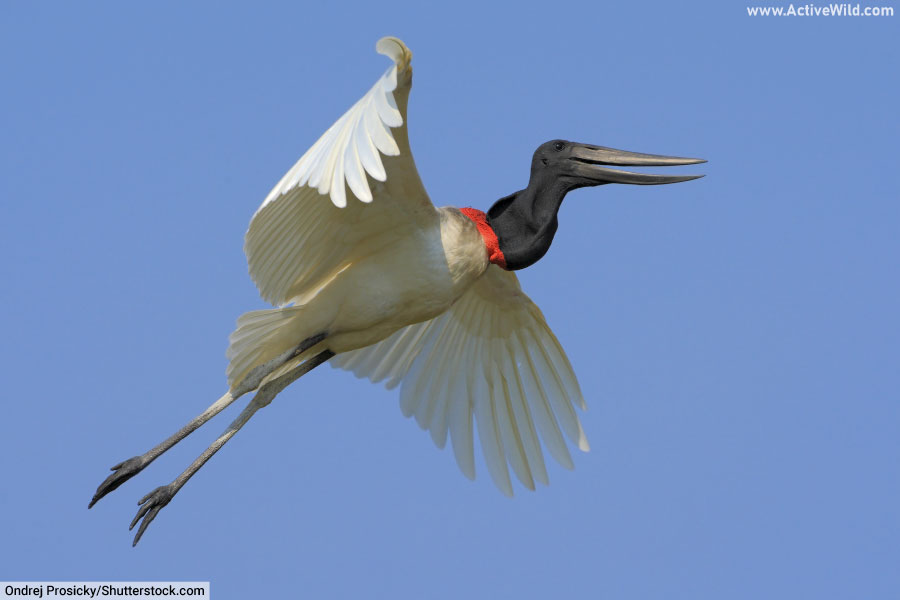
Scientific name: Jabiru mycteria
Family: Ciconiidae
IUCN Conservation Status: Least Concern
The Jabiru is a large, striking stork found in wetlands and swamps across Central and South America. Measuring up to 5 feet in height with a wingspan of over 8 feet, it is one of the tallest flying birds in the Americas.
The most distinguishing features of this weird bird include its massive black bill, bare black head and neck, and white plumage.
The Jabiru primarily feeds on fish, amphibians, and reptiles, using its large bill to snatch prey from the water. A solitary forager for most of the year, the Jabiru forms monogamous pairs during the breeding season, and builds large nests high in trees.
Discover More with Active Wild
You can see more North American animals on this page: North American Animals
You can see more South American animals on this page: South American Animals
Kagu
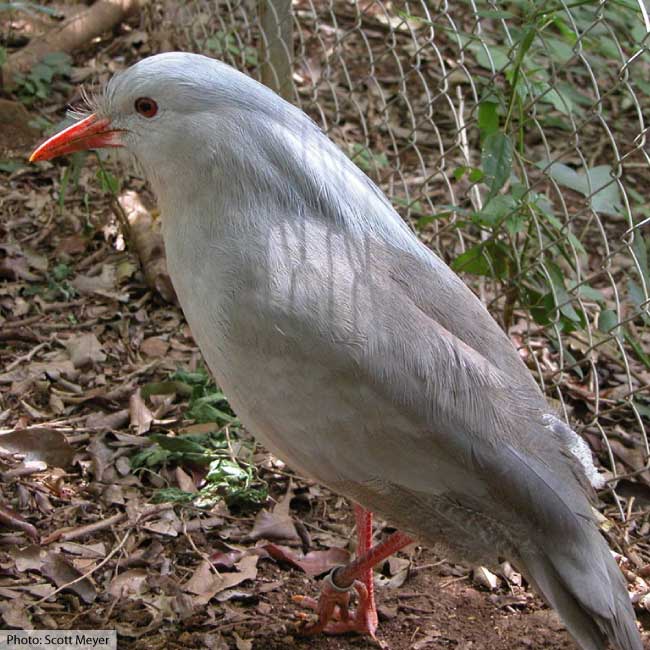
Scientific name: Rhynochetos jubatus
Family: Rhynochetidae
IUCN Conservation Status: Endangered
The Kagu is a unique bird endemic to the dense forests of New Caledonia, a group of islands in the South Pacific. The species has a distinctive appearance, with ash-gray plumage, bright red legs, and a long, shaggy crest on its head. It is virtually flightless, using its wings for displaying and occasionally gliding.
The Kagu has an intricate courtship display, in which it fans out its wings and emits a series of calls. The species is primarily insectivorous, using its curved bill to forage in leaf litter. The bill has bumps known as “nose corns” over the nostrils – features not seen on any other bird species.
As a result of habitat loss, introduced predators, and its limited distribution, the Kagu is classified as endangered.
Discover More with Active Wild
You can see more Asian animals on this page: Asian Animals
Kakapo
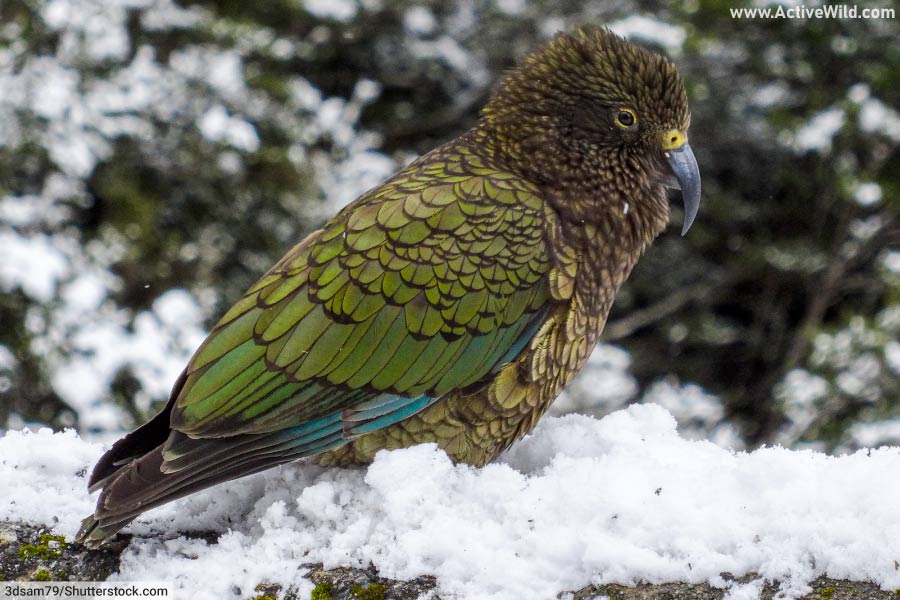
Scientific name: Strigops habroptilus
Family: Strigopidae
IUCN Conservation Status: Critically Endangered
One of the world’s weirdest birds is the kakapo, a large, nocturnal, flightless parrot native to New Zealand.
The kakapo is the world’s heaviest parrot, weighing up to 9 pounds, and has an exceptionally strong sense of smell. It has soft, moss-green feathers mottled with black and brown, which provide excellent camouflage in its forest habitat.
Although being the world’s only flightless parrot, the kakapo is a good climber and often found high up in the trees. It uses its small wings for balance.
The diet of the kakapo consists of native plants, seeds, and fruits. The species is critically endangered due to habitat loss and predation by introduced mammals.
Intensive conservation efforts, including translocations to predator-free islands, have been implemented to save the remaining kakapo population, which numbered fewer than 200 individuals as of 2021.
Discover More with Active Wild
You can see more animals that begin with K on this page: Animals That Start With K
Long-Wattled Umbrellabird

Scientific name: Cephalopterus penduliger
Family: Cotingidae
IUCN Conservation Status: Vulnerable
The Long-Wattled Umbrellabird is a weird bird found in the humid forests of western Colombia and Ecuador.
The male is characterized by its all-black plumage, an umbrella-like crest on its head, and a long, inflatable wattle (a fleshy growth) hanging from its throat. The wattle can be over a foot in length. Females have a shorter wattle and a less pronounced crest.
Males use their wattles during courtship displays, inflating them to produce deep, booming calls.
The Long-Wattled Umbrellabird feeds mainly on fruit, as well as insects and small vertebrates. Due to habitat loss and hunting, the Long-Wattled Umbrellabird is classified as vulnerable.
Discover More with Active Wild
You can see more rainforest animals on this page: Rainforest Animals List with Pictures & Facts
You can see more South American animals on this page: South American Animals
Lyrebird
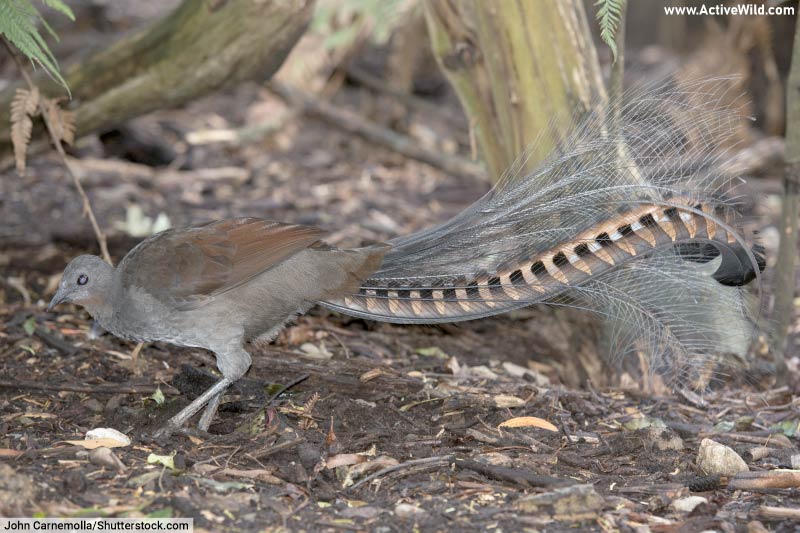
Genus: Menura
Family: Menuridae
IUCN Conservation Status: Least Concern (both species)
Lyrebirds are renowned for their extraordinary vocal abilities and elaborate courtship displays. There are two species, the Superb Lyrebird (Menura novaehollandiae) and Albert’s Lyrebird (Menura alberti). Both are native to the forests of southeastern Australia.
Lyrebirds are named for the male’s magnificent, lyre-shaped tail feathers, which are fanned out during courtship dances.
Both species of lyrebird are accomplished mimics, able to reproduce a wide range of natural and artificial sounds, including other birds’ songs, machinery, and even human voices.
Lyrebirds primarily feed on insects, spiders, and other small invertebrates, using their powerful legs and claws to scratch through leaf litter.
Discover More with Active Wild
You can see more Australian animals on this page: Australian Animals
Discover more Australian birds on this page: Australian Birds
Frigatebirds

Family: Fregatidae
IUCN Conservation Status: Least Concern
Frigatebirds are large seabirds found in tropical and subtropical regions around the world. The five species (source) of frigatebirds make up the family Fregatidae. They are known for their long, slender wings, deeply forked tails, and, in particular, for the distinctive red throat pouch of the males. This pouch, which is known as a “gular pouch”, is inflated during courtship displays. Females are slightly larger than males, and have white chests.
With wings that are among the largest–in comparison to body weight–of all birds, frigatebirds are skilled and highly-efficient flyers. Frigatebirds hunt their own food, but these “pirates of the sky” also engage in kleptoparasitic behavior – i.e., stealing food from other seabirds in mid-flight.
Discover More with Active Wild
You can see more ocean animals on this page: Ocean Animals List with Pictures & Facts
Marabou Stork
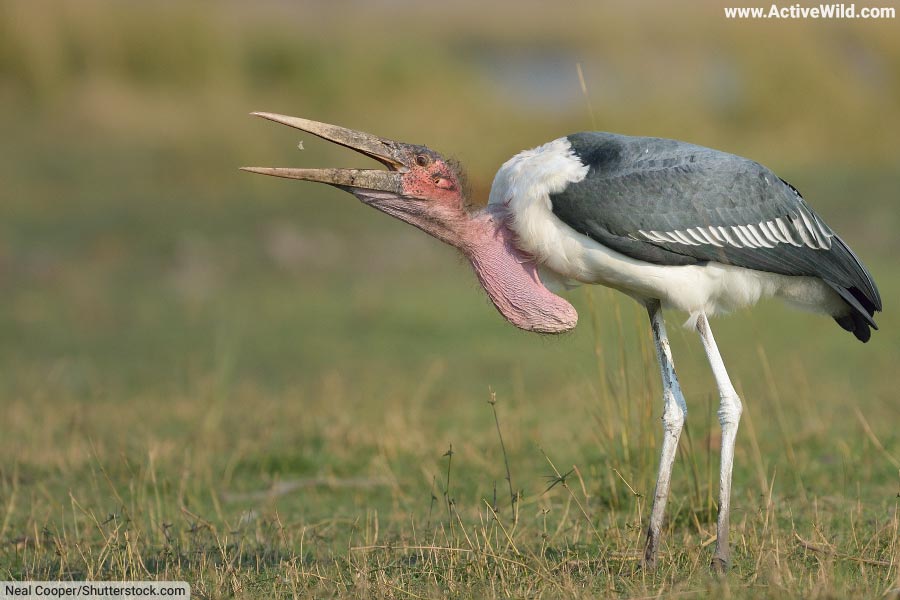
Scientific name: Leptoptilos crumenifer
Family: Ciconiidae
IUCN Conservation Status: Least Concern
The Marabou Stork is a large bird native to Africa’s savannas, wetlands, and grasslands. Standing over 5 feet tall with a wingspan of up to 12 feet, it has a bald head, a massive bill, and a distinctive, inflatable throat sac. The species’ plumage is mostly black and white, with a ruff of long, white feathers around the neck.
This weird-looking bird is an opportunistic feeder, consuming carrion, fish, frogs, small mammals, and even other birds. It is often seen congregating around carcasses, garbage dumps, or other sources of food.
Discover More with Active Wild
You can see more African animals on this page: African Animals
Oilbird
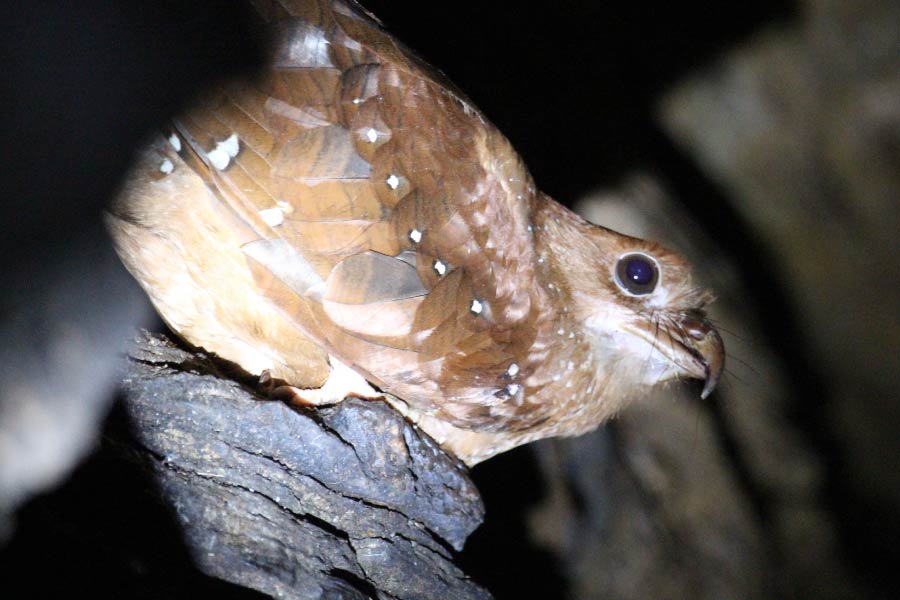
Scientific name: Steatornis caripensis
Family: Steatornithidae
IUCN Conservation Status: Least Concern
The Oilbird is a nocturnal bird found in the forests and caves of northern South America. It has a unique appearance, with a hooked bill, whisker-like bristles around its mouth, and reddish-brown plumage.
This weird species is the only bird that relies on echolocation to navigate in the dark, emitting clicks and using the returning echoes to build a mental map of its surroundings.
The Oilbird feeds primarily on fruit, particularly the fatty fruits of oil palms, which give the bird its name.
A social species, the oilbird roosts and breeds in large colonies in caves. Its conservation status is “Least Concern.”
Discover More with Active Wild
You can see more nocturnal animals on this page: Nocturnal Animals List with Pictures & Facts
Philippine Eagle
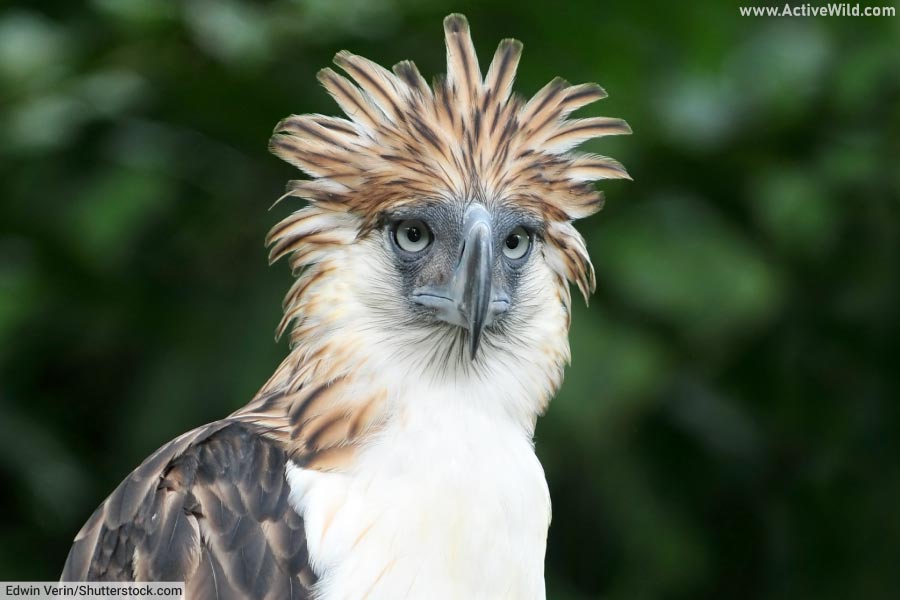
Scientific name: Pithecophaga jefferyi
Family: Accipitridae
IUCN Conservation Status: Critically Endangered
The Philippine Eagle, also known as the Monkey-Eating Eagle, is a powerful raptor native to the Philippines.
One of the world’s largest and most majestic eagles, the Philippine Eagle has wingspan of up to 7 feet and striking plumage that includes a shaggy crest of feathers on its head.
The Philippine Eagle is a top predator, preying on mammals, birds, and reptiles, with a particular preference for flying lemurs and monkeys. It forms monogamous pairs, breeding only once every two years and maintaining a lifelong bond with its mate.
Due to habitat loss, hunting, and its slow reproductive rate, the Philippine Eagle is critically endangered, with only a few hundred individuals remaining in the wild.
Discover More with Active Wild
You can see more Asian animals on this page: Asian Animals
You can see more critically endangered animals on this page: Critically Endangered Species
Potoos
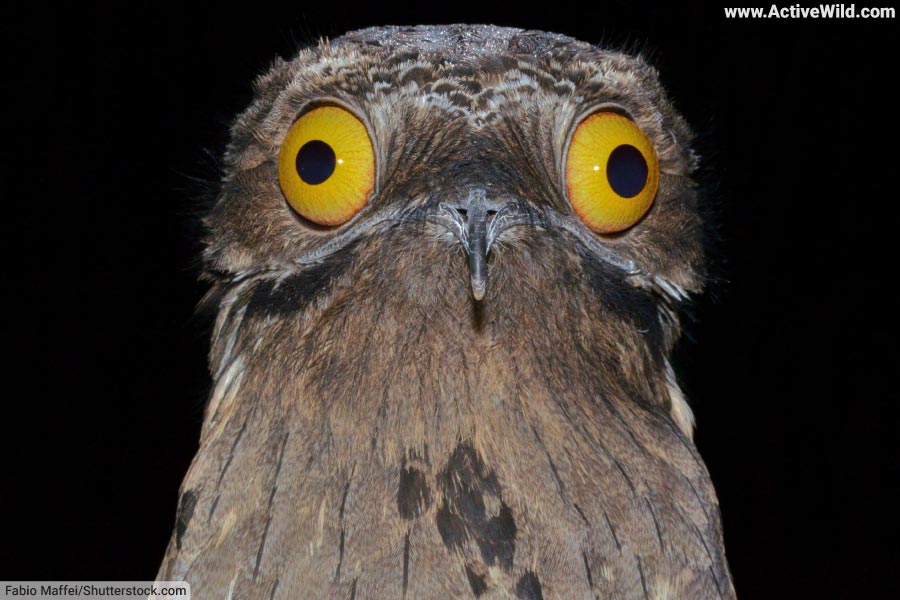
Family: Nyctibiidae
IUCN Conservation Status: Least Concern (all seven species)
Potoos are a family of nocturnal birds found throughout Central and South America. These weird birds are known for their cryptic plumage and distinctive, wide-mouthed appearance. They have large, forward-facing eyes, which provide excellent night vision, and their plumage resembles tree bark, allowing them to blend in with their surroundings.
During the day, potoos perch motionless on tree branches, mimicking broken stumps to avoid detection. At night, they come to life, hunting for insects and small animals on the wing.
There are seven species of potoos, each with its own distinct vocalizations, which range from eerie wails to haunting whistles.
Discover More with Active Wild
You can see more South American animals on this page: South American Animals
Ratites
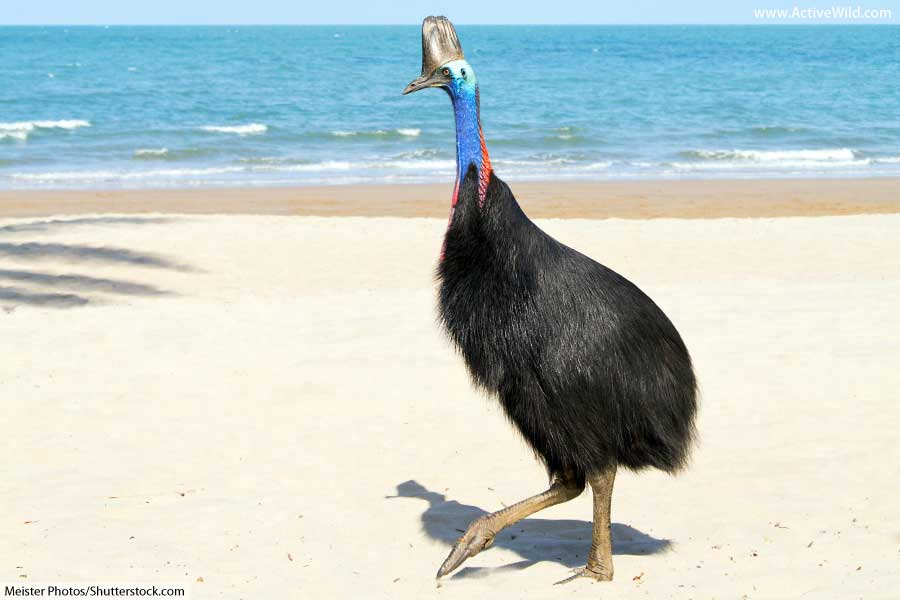
Infraclass: Palaeognathae
Family: Various families
Ratites are a group of flightless birds that include ostriches, emus, cassowaries, rheas, and kiwis. They are characterized by their flat breastbones, which lack the keel structure needed for flight, and their strong, muscular legs adapted for running or walking.
Ratites have small, vestigial wings and have loose, hair-like feathers. They live in a diverse range of habitats, from arid savannas to dense forests, and their diets vary accordingly, including plant material, insects, and small vertebrates.
The conservation status of ratites differs by species, with some, like the common ostrich, classified as “Least Concern,” while several species of kiwi, face significant threats from habitat loss and predation.
Discover More with Active Wild
You can find out more about ostriches on this page: Ostrich Facts
You can find out more about cassowaries on this page: Cassowary Facts
Secretary Bird
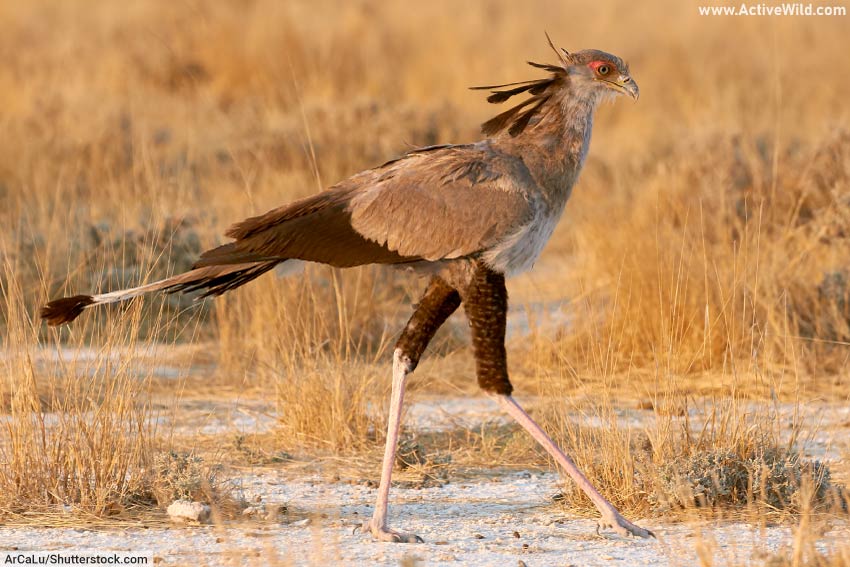
Scientific name: Sagittarius serpentarius
Family: Sagittariidae
IUCN Conservation Status: Endangered
The Secretary Bird is a distinctive raptor native to the grasslands and savannas of sub-Saharan Africa. It stands over 4 feet tall, with long, slender legs, a hooked bill, and a striking crest of long, black feathers on its head.
Unlike most raptors, the Secretary Bird spends much of its time on the ground, hunting for prey such as snakes, lizards, rodents, and small birds. It is known for its unique method of killing snakes by stomping on them with its powerful legs.
The Secretary Bird faces threats from the continued loss of its grassland habitat, human-wildlife conflict, and declining prey populations. Sadly, this weird bird is now endangered.
Discover More with Active Wild
You can see more carnivorous animals on this page: Carnivores Examples
You can see more African animals on this page: African Animals
Shoebill
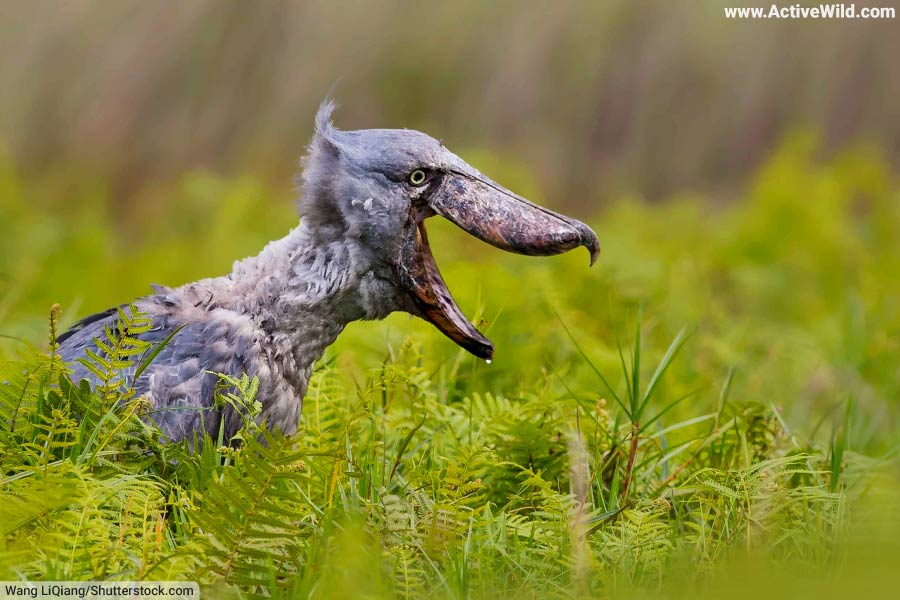
Scientific name: Balaeniceps rex
Family: Balaenicipitidae
IUCN Conservation Status: Vulnerable
The Shoebill is a large bird found in the swamps and wetlands of central tropical Africa. It gets its name from its massive, shoe-shaped bill, which is used to catch prey such as fish, frogs, and reptiles.
The Shoebill’s gray plumage, broad wings, and long legs make it an impressive sight in its native habitat.
While hunting, the species waits motionless for prey before striking with lightning speed.
Discover More with Active Wild
You can see more carnivorous animals on this page: Carnivores Examples
You can see more African animals on this page: African Animals
Silkie Chicken
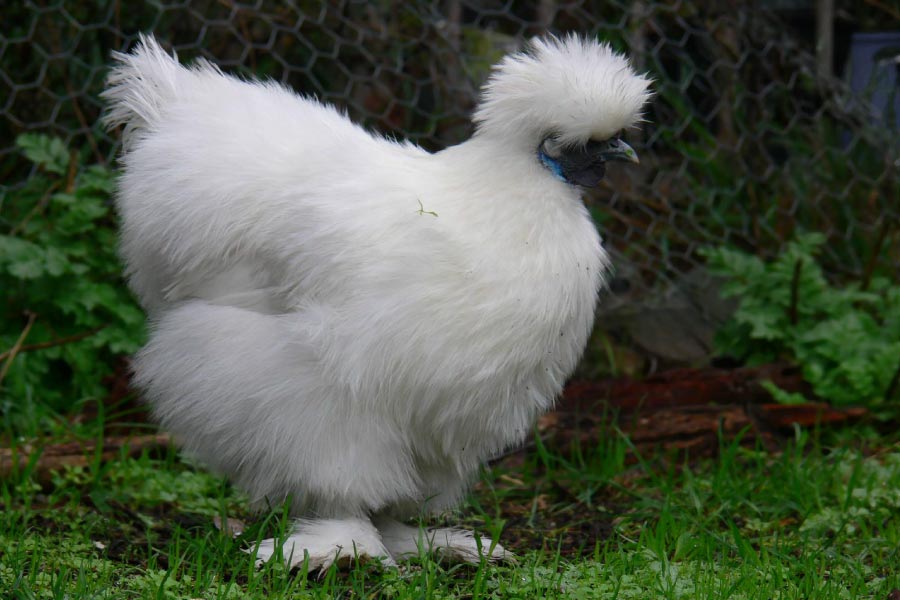
Scientific name: Gallus gallus domesticus (Silkie variety)
Family: Phasianidae
IUCN Conservation Status: Not applicable (domestic breed)
The Silkie Chicken is a unique breed of domestic chicken known for its soft, fluffy plumage, which feels similar to silk or fur.
Originally from Asia, Silkie Chickens have become popular worldwide as pets and show birds due to their striking appearance and gentle temperament.
These weird domestic birds are relatively small, with a round body, a crest of feathers, and feathered feet. Another unique feature of Silkies is their black skin, bones, and dark blue flesh.
Silkie Chickens are also known for their strong brooding instincts, often being used to hatch eggs of other chicken breeds or even other bird species.
Tufted Puffin

Scientific name: Fratercula cirrhata
Family: Alcidae
IUCN Conservation Status: Least Concern
The Tufted Puffin is a striking seabird native to the North Pacific Ocean, known for its colorful breeding plumage and distinctive facial features.
During the breeding season, adults develop bright yellow tufts of feathers above their eyes, a white face, and a large, orange-red bill.
Tufted Puffins are skilled divers, feeding primarily on fish and invertebrates, which they catch underwater. They nest in colonies on rocky cliffs and islands, laying their eggs in burrows or crevices.
Discover More with Active Wild
You can find out more about birds on this page: Birds – The Ultimate Guide
Discover different types of birds on this page: Types of Birds
Vampire Ground Finch

Scientific name: Geospiza septentrionalis
Family: Thraupidae
IUCN Conservation Status: Vulnerable
The Vampire Ground Finch is a small bird native to the Galápagos Islands. It belongs to a group of Galápagos birds known as Darwin’s finches, which, despite the name, are members of the tanager family and not true finches.
The Vampire Ground Finch is named for its unusual feeding behavior, which involves pecking at the skin of seabirds like boobies, consuming their blood for sustenance. This behavior is thought to be an adaptation to the scarce food resources in their island habitat.
In addition to blood, Vampire Ground Finches consume seeds, insects, and nectar. They are small birds with black plumage, a short, stout bill, and a distinctive white patch on their forehead.
Discover More with Active Wild
You can find out more about birds on this page: Birds – The Ultimate Guide
Discover different types of birds on this page: Types of Birds
Victoria Crowned Pigeon

Scientific name: Goura victoria
Family: Columbidae
IUCN Conservation Status: Near Threatened
The Victoria Crowned Pigeon is a striking, large pigeon native to the lowland forests of New Guinea.
Named after Queen Victoria, the species is easily recognized by its ornate, lacy crest of feathers on its head, which resembles a crown. The pigeon’s plumage is predominantly blue-gray, with deep red eyes and a striking maroon breast.
Victoria Crowned Pigeons are ground-dwelling birds that forage for fallen fruit, seeds, and small invertebrates. They are known for their deep, resonant calls and elaborate courtship displays.
The species faces threats from habitat loss and hunting, resulting in its classification as “Near Threatened.”
Discover More with Active Wild
You can find out more about birds on this page: Birds – The Ultimate Guide
Discover different types of birds on this page: Types of Birds
Vulturine Guineafowl

Scientific name: Acryllium vulturinum
Family: Numididae
IUCN Conservation Status: Least Concern
The Vulturine Guineafowl is the largest and most striking species of guineafowl. Native to the grasslands and savannas of eastern Africa, the Vulturine Guineafowl gets its name from its vulture-like appearance, with a small, bald head and neck, and a long, hooked bill. The bird’s body is covered in striking blue and black plumage, with white spots and a long, drooping tail.
A social species, the Vulturine Guineafowl lives in large groups, foraging for seeds, insects, and small vertebrates on the ground. They are known for their distinctive, high-pitched calls and strong, fast-running ability.
Discover More with Active Wild
You can see more African animals on this page: African Animals
Related Pages
See more weird animals on the following pages:
Discover more about birds on the following pages:

